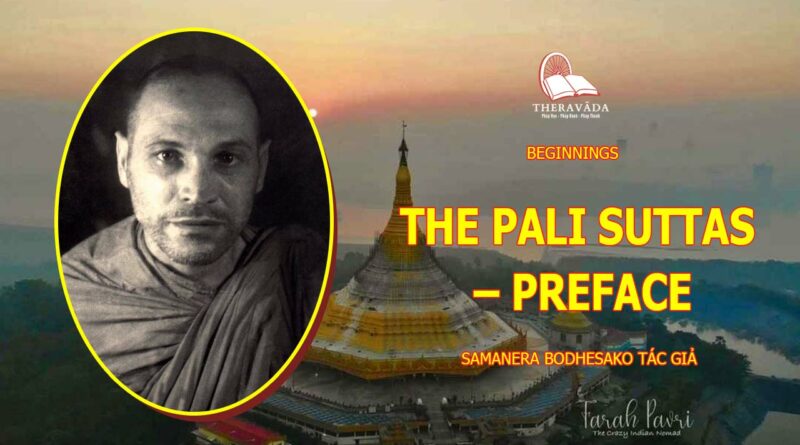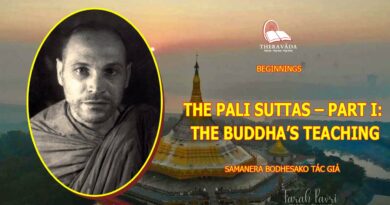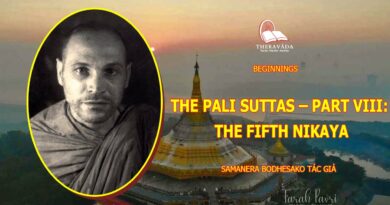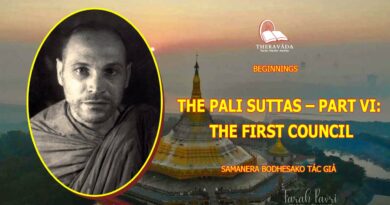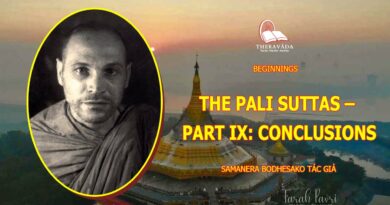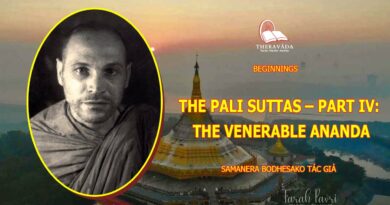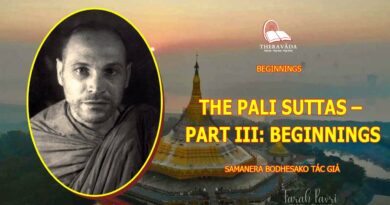Nội Dung Chính [Hiện]
BEGINNINGS: THE PALI SUTTAS – PREFACE
Preface
A discussion of beginnings would be entirely unnecessary were it not that beginnings seem invariably to precede whatever conclusions may exist. Therefore any who hope to arrive at a conclusion in their life must perforce begin. But where? The present work is concerned entirely with this question. Herein our discussion is, by design, twofold.
First, we will discuss the human situation, and the inherent need to discover a method, a way, whereby we may resolve the dilemma of that situation. This method must be coherent: we must have a standard whereby we can judge which actions will and which will not lead us towards a conclusion. Accepting a standard is, precisely, our beginning.
Second, we will discuss whether the collection of texts known as the Pali Suttas might not offer such a standard. These texts, the oldest we have from among the various Buddhist schools, have much to recommend them. However, objections have been raised concerning their authenticity. These objections refer to the very origins and the early transmission of the Suttas. In order to evaluate these objections an understanding is needed of how these texts came into being and how they were passed on. This is the second sense in which we are concerned about beginnings.
Although this historical point occupies the bulk of our essay, it is thematically subservient to our primary question — Where does one begin? — and is relevant only to the extent that the primary question is seen to be relevant. This work, then, is not historical as such. Rather, it happens that an inquiry into the primary question turns out to involve an historical consideration.
The objection may be raised that any teaching which calls itself akalika, or non-temporal, as the Pali Suttas do, can never be understood by raising an historical question, which is necessarily temporal. This of course is perfectly true. The problem of existence, in its very nature, can never be resolved by such a method. It is only through a non-historical approach — specifically, one that is personal, passionate, and persistent — that our perilous situation in the world can ever be comprehended. In this sense the only basis for judging the Suttas would be to put their advice into practice and resolve the personal dilemma, thereby coming to know for certain that the Suttas are what they claim to be. But herein we are not yet at the point of discussing how to proceed. We are still involved with the prior question of whether these Suttas offer a standard which, if acquiesced to, will lead to an end. And although an historical inquiry can never in itself lead us to a conclusion, it is at least possible that it might lead us to a beginning inasmuch as it can serve as an initial indication to our question: Where does one begin?
Except where otherwise noted, all factual information in this essay is garnered from the Pali Suttas and their companion-piece, the Vinaya. In these texts we find accounts of the first months following the Buddha’s awakening (Khandhaka I, Mahavagga, Vinaya), of the final months before his decease (Sutta 16, Digha Nikaya), of the events leading up to the First and Second Councils, together with an account of those Councils (Khandhakas XI and XII, Culavagga, Vinaya), and, scattered through the texts, incidental information and clues about the middle period of the Buddha’s ministry. Considerable additional information is available in texts of later date, such as the Commentaries. However, for our purposes such data are not needed, for though our account in no way contradicts the known facts available from primary sources, it is our intention to present here not a factual history but an imaginative one. We may recall the dictum: “Higher than actuality stands possibility.” We are not attempting to set forth what did happen but what must have happened. Our account is more reasoned than reportorial. As such our methods are not those of scholars; nor do our conclusions rest upon ever finer points of contention, but rather upon a commonly-held understanding of how, in their broad outlines, things generally evolve: gradually and piecemeal rather than suddenly and definitively.
This is not to say that what follows will be of no interest to scholars. On the contrary, because of the broadness of the base upon which our findings rest, it is hoped that scholars may well regard them as a significant as well as an original contribution to their discipline. However, an understanding of what follows requires no knowledge of or interest in scholarly questions. For most, perhaps, this account will be sufficient. For those who feel that they would benefit by further exploration into the substantial scholarly literature on the early history of Buddhism, this account can serve as a standard for evaluating the various conflicting views and judgements that are to be encountered therein. Avoiding those conflicts, we offer herein, using the data of the texts themselves, the most reasonable account of their beginnings and a reasonable assessment of how much confidence we can place in them, in order to make our own beginning.
Sutta references are to discourse number and, in parentheses, volume and page of the Pali Text Society edition, except for Theragatha, Dhammapada and Sutta Nipata, for which reference is to the verse number. Vinaya references are to the Khandhaka number of the Mahavagga or Culavagga, in Roman numerals, followed in Arabic numerals by subsection and paragraph as well as volume and page number.
Vin.: Vinaya Pitaka
D.: Digha Nikaya
M.: Majjhima Nikaya
S.: Samyutta Nikaya (Roman numerals indicate Samyutta number,
according to P.T.S. enumeration)
A.: Anguttara Nikaya (Roman numerals indicate Nipata number)
Thag.: Theragatha
Dh.: Dhammapada
Sn.: Sutta Nipata
Ud.: Udana
Source: Budsas.net

